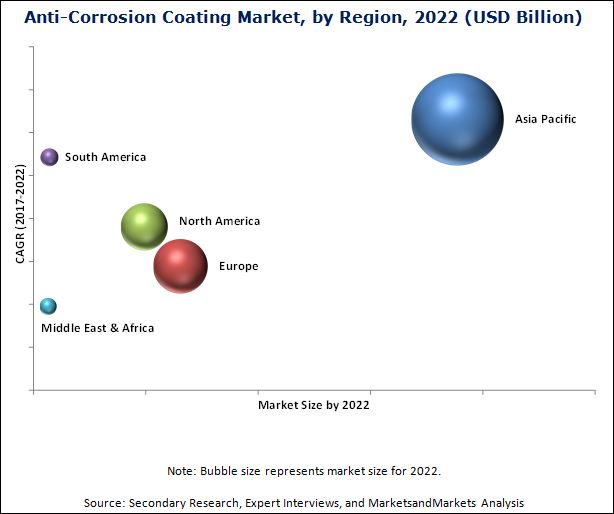The report "Passive Fire Protection Coatings Market
by Type (Intumescent, Cementitious), Technology (Water-Based,
Solvent-Based), End-Use Industry (Building & Construction, Oil &
Gas, Transportation), and Region - Global Forecast to 2022",
The passive fire protection coatings market is projected to reach USD
4.02 Billion by 2022, at a CAGR of 6.6% from 2017 to 2022.
The use of passive fire protection coatings has increased due to stringent government regulations regarding the usage of passive fire protection coatings and fire safety standards. In addition, the rapidly growing building & construction industry is expected to lead to an increase in the demand for passive fire protection coatings. Oil & gas and transportation are the other industries which demand passive fire protection coatings.
Download PDF Brochure: https://www.marketsandmarkets.com/pdfdownload.asp?id=165549042
The use of passive fire protection coatings has increased due to stringent government regulations regarding the usage of passive fire protection coatings and fire safety standards. In addition, the rapidly growing building & construction industry is expected to lead to an increase in the demand for passive fire protection coatings. Oil & gas and transportation are the other industries which demand passive fire protection coatings.
Download PDF Brochure: https://www.marketsandmarkets.com/pdfdownload.asp?id=165549042
The intumescent coatings type fire protection
coatings segment accounted for the largest share of the passive fire
protection coatings market in 2016
Intumescent coatings type fire protection coatings
was the largest type segment of the passive fire protection coatings
market, in terms of value in 2016. This high market share is mainly
attributed to its usage across various applications, such as commercial
buildings, restaurants, hospitals, colleges, residential buildings,
skyscrapers, and offices, and the oil & gas industry, among others.
The value market of intumescent coatings is higher as compared to
cementitious coatings as, intumescent coatings are used in combination
with cladding materials. Intumescent coatings require lower maintenance,
improve durability, provide longer shelf-life, and also provide
corrosion protection for steel structures in buildings. Hence, these
properties of intumescent coatings are expected to foster the growth of
these type of coatings in the passive fire protection coatings market.
The water-based technology of fire protection
coatings accounted for the largest share of the passive fire protection
coatings market in 2016
The water-based technology segment of the passive
fire protection coatings market accounted for the largest share, in
terms of both, value and volume, in 2016. Water-based fire protection
coatings are extremely safe as they do not contain harmful solvents, are
low odor and have low VOC emissions. These are developed to enable
customers to meet the stringent emission standards set by various
agencies, such as, Registration, Evaluation, Authorization, and
Restriction of Chemicals (REACH) and the Environmental Protection Agency
(EPA). Also, these water-based coatings can withstand high humidity
levels during application. The above factors are fueling the demand for
the water-based technology in the passive fire protection coatings
market.
Request For FREE Sample Pages @ https://www.marketsandmarkets.com/requestsample.asp?id=165549042
The market for fire protection coatings in
the building & construction industry is expected to grow at the
highest CAGR during the forecast period
The building & construction industry is expected
to register the highest growth, in terms of both, value and volume
during the forecast period. Fire protection coatings are used in
buildings owing to the various benefits that these provide. These
coatings prolong the time period of damage that could be caused,
providing ample time to evacuate a building in case of fire. Moreover,
these also help in the protection of firefighters while controlling the
fire and hence help reduce damage to a structure and loss of assets.
Building & construction is one of the major
applications of passive fire protection coatings. These are used in
construction activities to protect buildings to enable withstanding
fire. Such coatings are applied so that the steel structures used in
building & construction can withstand a fire and prevent the steel
from reaching the critical temperature which could lead it to collapse.
Passive fire protection coatings are mainly used in high rise buildings,
sports stadiums, residential, and commercial construction.
The passive fire protection coatings market
in the Asia-Pacific is expected to grow at the highest CAGR during the
forecast period
The Asia-Pacific is the largest market for passive
fire protection coatings, in terms of both, value and volume, and is
expected to be the fastest-growing region. Increasing industrialization
and end-use industries are expected to lead to an increase in the demand
for passive fire protection coatings in this region. The booming
construction industry is expected to drive the demand for passive fire
protection coatings in buildings in the public and private sectors in
this region. The regulations in this region are a driver for the passive
fire protection coatings market. Moreover, the rising middle-class
population coupled with increasing consumer spending has further
contributed to the high demand in Asia-Pacific countries, such as China,
Japan, and India.
Key players in the passive fire protection coatings market
Key players operating in the passive fire protection
coatings market include Akzo Nobel (The Netherlands), PPG Industries
(US), The Sherwin-Williams Company (US), Promat International (Belgium),
Carboline (US), Hempel A/S (Denmark), KANSAI PAINT (Japan), Nullifire
(UK), Jotun (Norway), and Teknos Group (Finland).



